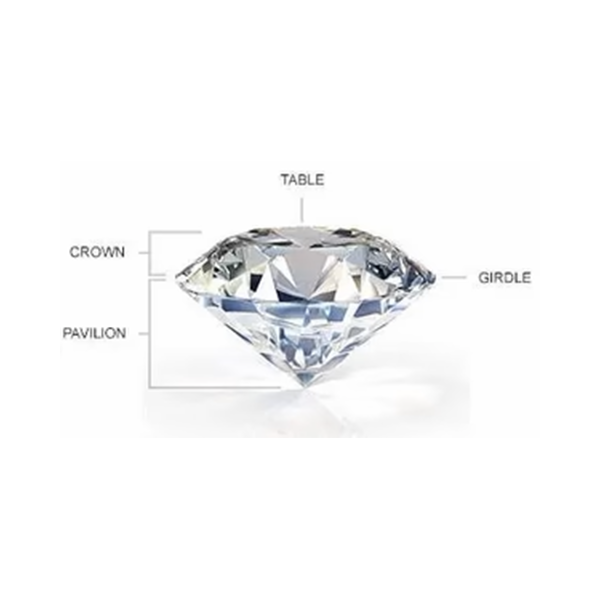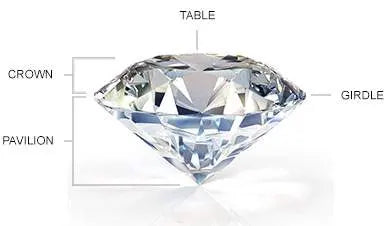
You’ve likely heard of “the 4 Cs” when jewelers talk about diamonds: cut, color, clarity, and carat weight. Those are certainly a fine starting point in getting to know some of the elements that contribute to a fantastic diamond, but it’s certainly not all of them. When a gemologist or the top diamond buyers in the world are looking at a diamond, they are looking at five structural elements found in all diamonds: table, crown, girdle, pavilion, and culet. Examining those elements and the angles of the cuts are the things an experienced professional is checking with every diamond.

Table
The flat, topmost surface of a diamond is the table. It’s also the largest facet of the diamond, and the light that enters and reflects back through the table is where most of the brilliance of diamonds comes from. Most of the flashes and sparkles you see coming from a diamond come from the table, and it’s an important factor gemologists when they assign a cut grade to a diamond.
Girdle
The widest part of the diamond is called the girdle. This is at the outmost edge where the crown and pavilion connect (see below). The width of the girdle is also a key part gemologists use when assigning a cut grade. In a halo or bezel ring setting, the girdle is typically hidden and level with the metal as it meets the diamond. In a prong or channel set, the girdle is seen where no metal touches the diamond. The size must be precise. If it is too thick or too thin, the diamond only gets a “good” or “very good” cut.
Crown
A diamond’s crown is everything that sits above the girdle (see above). Much like the table, the crown is where refracted light passes and then bounces back up through the part of the diamond known as the pavilion. It’s the various facets of the crown that will bounce colorful and stunning fire back to your eyes.
Pavilion
The area that begins at the girdle and ends at the culet is known as the pavilion. The pavilion is considered the most valuable part of a diamond, and it’s where the bulk of the weight typically is. But even more important than the size is how the pavilion is cut. A pavilion that is too deep makes the diamond appear darker, since it limits the amount of light that bounces back to your eyes. If the pavilion is too shallow, you’ll find that the diamond is too dull and lacking in scintillation.
Culet
The culet is found at the very bottom of a diamond’s pavilion. Sometimes it comes to a tiny point, while other times it’s a small facet parallel with the table. The smaller the culet, the more brilliant a diamond is. When looking down through the table, you are looking directly at the culet. If it is too large, light will escape through the bottom, as opposed to reflecting back and upwards. This will leave a noticeable dark circle.
Those five elements, along with some very specific math and precise geometry, are the items the pros are looking for, and now you can too!


